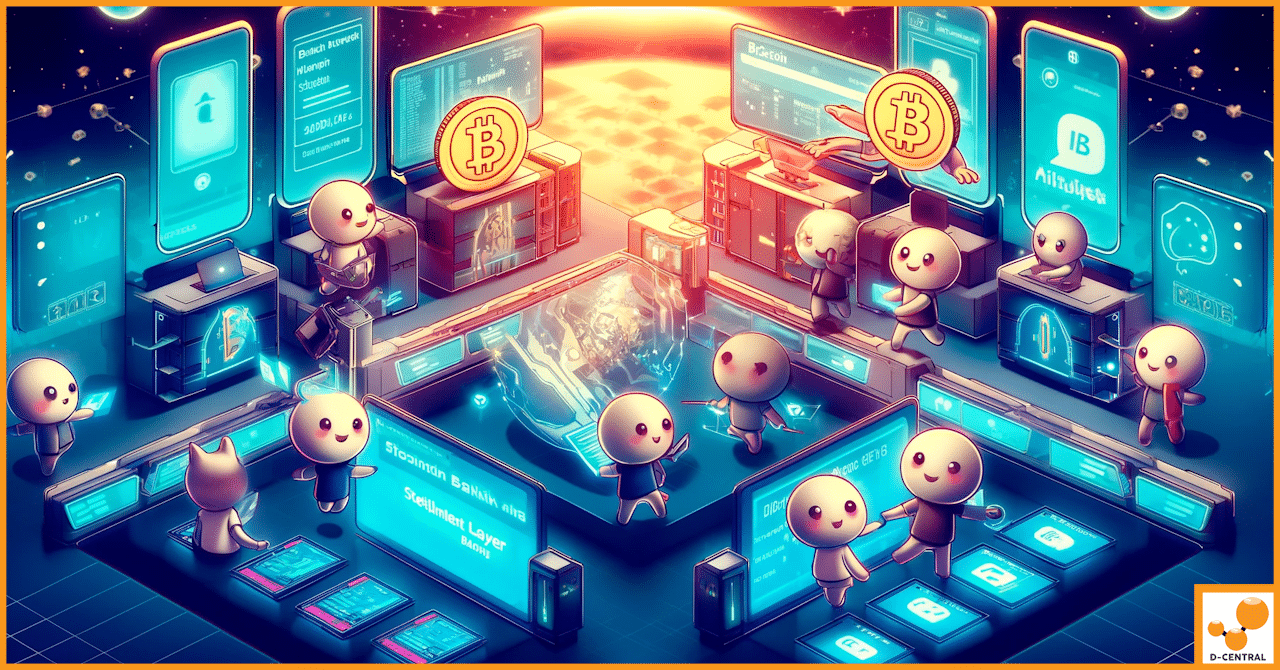
Noise Reduction Techniques for Home Bitcoin Miners: A Comprehensive Guide
Welcome to our in-depth guide on managing noise levels for home Bitcoin miners. As cryptocurrency enthusiasts, we understand the importance
4479 Desserte Nord Autoroute 440, Laval, QC H7P 6E2

In the digital age, the concept of estate planning has expanded beyond the traditional boundaries of physical assets and financial instruments to include a new, critical category: digital assets. Among these, cryptocurrencies, with Bitcoin at the forefront, represent a significant portion of modern wealth for many individuals. The decentralized nature of Bitcoin and other digital currencies introduces unique challenges and complexities in the realm of estate planning, necessitating innovative solutions to ensure the secure and intentional transfer of these assets upon one’s passing.
The importance of digital asset management in estate planning cannot be overstated. As these assets become increasingly integral to our financial portfolios, the need to securely manage and pass them on becomes a paramount concern. Traditional estate planning tools often fall short when applied to digital assets, given their unique characteristics such as cryptographic security, anonymity, and the absence of physical presence. This gap in traditional estate planning underscores the necessity for specialized strategies tailored to the digital domain.
Enter the concept of Bitcoin inheritance, a critical consideration for anyone holding cryptocurrencies. Bitcoin inheritance involves planning for the transfer of Bitcoin holdings after death, ensuring that beneficiaries can access and control these assets without compromising their security. The challenges here are manifold: from the technical hurdles of transferring cryptographic keys to the legal complexities surrounding digital assets, which often outpace current regulations and frameworks. Moreover, the risk of losing access to significant wealth due to lost keys or lack of proper planning highlights the urgent need for robust, secure methods to manage the inheritance of digital assets.
In addressing these challenges, innovative cryptographic solutions such as Shamir’s Secret Sharing, commonly referred to as Shamir Backup, have emerged as a beacon of hope. These technologies offer a way to securely and efficiently manage the transfer of digital assets after death, ensuring that the legacy of Bitcoin holders is preserved and passed on according to their wishes. As we delve deeper into the intricacies of digital asset management and Bitcoin inheritance, the role of such technologies becomes increasingly central, offering a bridge between the cutting-edge world of cryptocurrencies and the time-honored practices of estate planning.
The digital revolution has ushered in a new era of wealth, characterized by the emergence and proliferation of digital assets. These assets, ranging from cryptocurrencies like Bitcoin to digital tokens, non-fungible tokens (NFTs), and even digital rights and identities, represent a significant shift in how value is stored, transferred, and perceived in the modern world. Among these, cryptocurrencies have taken center stage, with Bitcoin leading the charge as a pioneer and the most widely recognized digital currency.
Cryptocurrencies, built on blockchain technology, offer a decentralized, secure, and transparent method of conducting transactions. Bitcoin, created in 2009 by an individual or group under the pseudonym Satoshi Nakamoto, was the first to introduce the concept of a decentralized digital currency. It operates on a peer-to-peer network, free from central authority control, making it not just a currency but a movement towards a more open and accessible financial system.
The significance of digital assets, particularly cryptocurrencies, extends far beyond their innovative technology or investment potential. They represent a fundamental shift in the concept of ownership and asset management. In the realm of estate planning, this shift brings both opportunities and challenges. Digital assets like Bitcoin are not only valuable but also highly secure and private, bound by cryptographic keys that grant access and control. This level of security and privacy, while a cornerstone of their appeal, also complicates their inclusion in traditional estate planning.
Estate planning for digital assets requires a nuanced understanding of the technology that underpins them, as well as the legal frameworks that govern their transfer and ownership. Unlike physical assets or traditional financial instruments, digital assets are governed by the codes and protocols of their respective blockchain networks. This means that access to and control over these assets is almost entirely dependent on the possession of private keys or seed phrases, which are often known only to the asset owner.
The rise of digital assets has thus necessitated a rethinking of estate planning strategies. Traditional wills and trusts may not suffice for the secure transfer of digital assets, as they often require the disclosure of sensitive information like private keys, posing a security risk. Moreover, the legal status of digital assets remains a gray area in many jurisdictions, further complicating their integration into estate plans.
In this context, the importance of specialized estate planning tools and strategies for digital assets becomes clear. Solutions like Shamir’s Secret Sharing for Bitcoin inheritance offer a way to navigate the complexities of digital asset transfer, ensuring that these modern forms of wealth are securely and effectively passed on to future generations. As digital assets continue to grow in prominence and value, their integration into estate planning will become an increasingly critical consideration for individuals and estate planners alike.
The advent of Bitcoin and other cryptocurrencies has introduced a paradigm shift in how assets are viewed, held, and transferred upon the owner’s death. Unlike traditional assets, which are often straightforward to bequeath and transfer through conventional legal mechanisms, Bitcoin inheritance presents a set of unique challenges that stem from the very nature of cryptocurrencies.
Addressing these challenges requires innovative approaches that respect the unique characteristics of Bitcoin and other cryptocurrencies. Solutions like Shamir’s Secret Sharing offer a way to securely and effectively manage Bitcoin inheritance, ensuring that digital assets are passed on according to the owner’s wishes without compromising on security, privacy, or the decentralized ethos of cryptocurrencies.
Shamir Backup, based on Shamir’s Secret Sharing scheme, is a cryptographic method designed to secure a secret by dividing it into multiple parts, known as shares. This innovative approach ensures that the secret can only be reconstructed when a sufficient number of shares are combined, providing a robust solution for secure data storage and retrieval, including the safeguarding of digital assets like Bitcoin.
Developed by Adi Shamir in 1979, Shamir’s Secret Sharing is a form of secure multi-party computation that allows a secret to be distributed among a group of participants. Each participant holds a share of the secret, and only when a predefined subset of these shares is brought together can the original secret be reconstructed. The beauty of this scheme lies in its flexibility: the secret can be split into any number of shares, and the threshold for reconstruction (i.e., the minimum number of shares required to recover the secret) can be customized based on the desired level of security and redundancy.
Adi Shamir, an Israeli cryptographer and co-inventor of the RSA encryption algorithm, introduced Shamir’s Secret Sharing in the context of safeguarding cryptographic keys and other sensitive information. The development of this scheme was motivated by the need for secure, distributed data storage methods that could protect against the loss or compromise of a single storage location. By enabling the division of a secret into multiple shares, Shamir’s Secret Sharing provided a novel solution that enhanced both the security and resilience of stored information.
The technical foundation of Shamir’s Secret Sharing, and by extension Shamir Backup, is based on polynomial interpolation, specifically the concept that it takes a minimum number of points (or shares) to uniquely define a polynomial of a given degree. In practical terms, the process involves the following steps:
Shamir Backup applies this scheme to the realm of digital asset security, particularly for safeguarding Bitcoin wallet recovery seeds. By splitting the seed into multiple shares and distributing them among trusted individuals or locations, the risk of total loss due to a single point of failure is mitigated. Moreover, this approach aligns with the principles of decentralization and self-sovereignty inherent in the cryptocurrency ethos, providing a secure and flexible method for managing the inheritance and backup of digital assets.
Shamir Backup, leveraging the principles of Shamir’s Secret Sharing scheme, plays a pivotal role in the realm of secure inheritance planning for digital assets like Bitcoin. This cryptographic method addresses the inherent challenges of passing on digital assets, offering a robust solution that aligns with the decentralized and secure nature of cryptocurrencies.
In the context of Bitcoin inheritance, Shamir Backup provides a sophisticated mechanism for ensuring that digital assets can be securely and reliably passed on to heirs or beneficiaries. The process involves splitting the private key or seed phrase of a Bitcoin wallet into multiple shares, which are then distributed among chosen participants, such as family members, trusted friends, or legal advisors. The key aspect of this approach is that no single participant holds enough information to access the assets independently, thereby safeguarding the assets from unauthorized access or theft.
The application of Shamir Backup in inheritance planning involves several critical steps:
Traditional single-key backup solutions, such as writing down a seed phrase on a piece of paper or storing it in a safe, present several limitations and risks, especially in the context of inheritance planning:
In contrast, Shamir Backup addresses these concerns by:
Shamir Backup thus offers a more secure, flexible, and resilient approach to Bitcoin inheritance planning, aligning with the principles of decentralization and security that underpin the cryptocurrency ecosystem. By leveraging this method, individuals can ensure that their digital legacy is preserved and passed on according to their wishes, without compromising on security or privacy.
Shamir Backup, as applied to Bitcoin inheritance, offers a multitude of advantages that address the inherent challenges of securing digital assets for future generations. This cryptographic approach not only enhances security but also introduces flexibility and privacy in the management and distribution of digital inheritance.
One of the primary advantages of using Shamir Backup for Bitcoin inheritance is the significant enhancement in security it provides. By dividing the critical information needed to access Bitcoin assets (such as a seed phrase or private key) into multiple shares, Shamir Backup eliminates the risk associated with having a single point of failure. This distributed approach means that the loss or compromise of one share does not jeopardize the entire inheritance, as no single share is sufficient to reconstruct the secret on its own.
Shamir Backup introduces unparalleled flexibility in how access to Bitcoin assets is managed and distributed among heirs or trusted individuals. This flexibility allows for tailored estate planning that can adapt to various personal, family, or business situations.
Shamir Backup also addresses privacy and security concerns inherent in the distribution and management of shares, ensuring that the process respects the confidentiality and integrity of the Bitcoin inheritance.
Shamir Backup offers a comprehensive solution for Bitcoin inheritance planning, addressing the critical needs for security, flexibility, and privacy. By leveraging this cryptographic method, individuals can ensure that their digital legacy is preserved and passed on securely and according to their wishes, without compromising the foundational principles of cryptocurrency ownership.
Incorporating Shamir Backup into your estate planning for Bitcoin assets involves careful consideration and a structured approach. This guide outlines the steps to set up Shamir Backup effectively and highlights best practices for share distribution and key legal and practical considerations.
Implementing Shamir Backup in your estate planning for Bitcoin assets provides a secure and flexible way to ensure that your digital legacy is passed on according to your wishes. By following these steps and best practices, and considering the legal and practical aspects, you can create a robust plan that safeguards your assets for future generations.
The evolution of digital assets, particularly cryptocurrencies like Bitcoin, has introduced a new dimension to estate planning, underscoring the critical need for secure and forward-thinking strategies to manage digital legacies. As these assets become increasingly integral to our financial portfolios, the importance of implementing robust mechanisms for digital asset inheritance planning cannot be overstated. It’s not just about preserving wealth; it’s about ensuring that the value we accumulate in the digital realm can be passed on to future generations in a manner that aligns with our intentions and safeguards their financial security.
Shamir Backup, rooted in the ingenious cryptographic scheme developed by Adi Shamir, stands out as a beacon of security and resilience in the landscape of digital asset inheritance. By enabling the division of crucial access information into multiple shares, it addresses the core challenges of digital asset inheritance, from eliminating single points of failure to enhancing privacy and flexibility in asset distribution. The role of Shamir Backup in safeguarding Bitcoin legacies is pivotal, offering a harmonious blend of cryptographic security and practicality that is essential for the effective management of digital estates.
However, the intricacies of implementing Shamir Backup and the broader nuances of digital estate planning underscore the value of professional guidance. Navigating the complexities of legal, technical, and security considerations demands expertise that spans both the cryptocurrency domain and estate planning principles. Therefore, individuals looking to secure their digital legacies are encouraged to consult with professionals who specialize in this niche intersection of fields. This collaborative approach ensures that estate plans are not only legally compliant and secure but also tailored to the unique needs and wishes of each individual.
For those seeking to fortify their Bitcoin inheritance plans, D-Central Technologies offers a suite of services designed to address the multifaceted challenges of digital asset management and inheritance. With a deep understanding of the cryptocurrency ecosystem and a commitment to security and client-centric solutions, D-Central stands as a trusted partner in the journey to secure digital legacies. We invite you to explore our offerings and engage with our experts to craft a personalized estate plan that ensures your digital assets are protected and seamlessly passed on to your heirs.
In the ever-evolving landscape of digital assets, taking proactive steps to secure your digital legacy is not just prudent; it’s imperative. With the right strategies, tools, and professional support, you can ensure that your Bitcoin and other digital assets are preserved and cherished by future generations, just as you intend.
What are digital assets in estate planning?
Digital assets in estate planning refer to any online accounts, cryptocurrencies like Bitcoin, digital tokens, non-fungible tokens (NFTs), and other digital rights and identities that form part of modern wealth. They require special consideration in estate plans due to their unique characteristics such as cryptographic security and the absence of physical presence.
Why is Bitcoin inheritance a critical consideration?
Bitcoin inheritance is critical because it involves planning the transfer of Bitcoin holdings after the owner’s death, ensuring beneficiaries can access and control the assets. Cryptocurrencies’ unique features, such as cryptographic security and decentralized nature, pose challenges in traditional estate planning and necessitate innovative solutions for secure transfer.
What is Shamir’s Secret Sharing (Shamir Backup)?
Shamir’s Secret Sharing, or Shamir Backup, is a cryptographic method that secures a secret (e.g., a Bitcoin wallet’s recovery seed) by dividing it into multiple parts or shares. This ensures the secret can only be reconstructed when a sufficient number of shares are combined, providing a secure solution for digital asset management and inheritance planning.
What challenges does passing on Bitcoin present?
Passing on Bitcoin presents challenges including the need for cryptographic key transfer, anonymity and decentralization issues, regulatory uncertainties, and technical knowledge barriers. These factors make securing, managing, and transferring Bitcoin upon an owner’s death complex.
How does Shamir Backup enhance digital estate planning?
Shamir Backup enhances digital estate planning by offering a secure and flexible way to manage Bitcoin inheritance. By splitting the private key or seed phrase into shares distributed among trusted individuals, it eliminates single points of failure, enhances privacy, and aligns with the principles of decentralization inherent in cryptocurrencies.
What are the advantages of using Shamir Backup for Bitcoin inheritance?
Advantages include enhanced security, preventing single points of failure, and offering flexibility in share distribution. It ensures that no single participant knows enough to access the assets on their own, providing a safeguard against theft and unauthorized access while preserving privacy.
How can one implement Shamir Backup in estate planning?
To implement Shamir Backup, one should understand its principles, select a reputable tool for generating shares, determine a distribution scheme, securely record and distribute shares among chosen participants, and include instructions for share combination in the estate plan. It’s advised to consult legal professionals for ensuring compliance and addressing complex requirements.
DISCLAIMER: D-Central Technologies and its associated content, including this blog, do not serve as financial advisors or official investment advisors. The insights and opinions shared here or by any guests featured in our content are provided purely for informational and educational purposes. Such communications should not be interpreted as financial, investment, legal, tax, or any form of specific advice. We are committed to advancing the knowledge and understanding of Bitcoin and its potential impact on society. However, we urge our community to proceed with caution and informed judgment in all related endeavors.
Related Posts

Welcome to our in-depth guide on managing noise levels for home Bitcoin miners. As cryptocurrency enthusiasts, we understand the importance

In the intricate world of financial transactions, the settlement layer serves as the backbone of traditional banking systems, ensuring the

As we embark on this journey to explore the Bitcoin halving cycle, it is essential to understand the fundamentals of